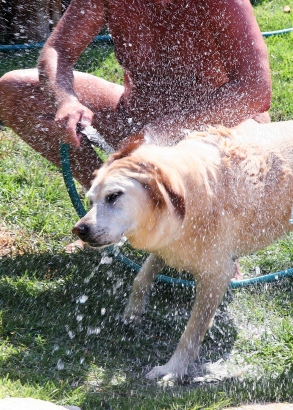Bathing
Always use dog shampoos on dogs. Human shampoos cause dry, scaly and itchy skin in many dogs. This is because dog and human skin are very different.
- Human skin is six times thicker.
- Pets’ hair growth is seasonal (cyclic), whereas our hair growth is continual.
- Dogs and cats shed their skin cells every 20 days. We shed skin cells every 28 days.
- The pH of human skin is 5.5 while dogs is 7.5.
 Do not bathe your dog more often than once a fortnight unless he has rolled in some unsavoury matter or your vet has prescribed a medicated shampoo.
Do not bathe your dog more often than once a fortnight unless he has rolled in some unsavoury matter or your vet has prescribed a medicated shampoo.
Rinse all traces of shampoo off after lathering and massaging the shampoo through the coat and down to the skin.
A good quality dog coat conditioner makes combing and brushing easier but rinse it off too.
Many dogs with skin problems are sensitive to the sulphates in many common dog shampoos. If your pet develops a rash or has dry, scaly or red skin after shampooing seek veterinary advice. If the skin is always dry and scaly ask about fatty-acid supplements and humidifying skin conditioners.
Clipping and grooming
Dogs generally enjoy grooming and soon relax into it. Most long-haired breeds need clipping every two months.
Poodles and other breeds who do not shed their coats soon get straggly and unkempt if their faces and feet are not trimmed regularly.
Pups as young as 12 weeks can be clipped. An early start gets them accustomed to the sound of the electric clippers and dryers, and to standing still for the groomer.
Thick-coated dogs like Old English Sheepdogs and Malamutes are often clipped short for the warmer months. This keeps them cool and comfortable, as well as exposing grass seeds and ticks.
The long silky coats of many terriers matt easily because the hair is so fine. The matts are cut away before bathing.
The hair in and around the ears and toes of Spaniels is clipped every two months.
Dogs lose some hair throughout the year but the thicker winter coat is shed in spring. You can aid the shedding process with daily combing and brushing. Use a comb for the feathering on the legs, and around the eyes and other sensitive parts of the body. The Mars Coat King is great for loosening and removing the mountains of dead hair along the sides and back.

